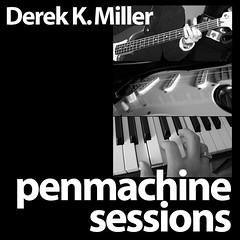Bass amplifier options
Permalinks to this entry: individual page or in monthly context. For more material from my journal, visit my home page or the archive.
I've had a few expressions of interest in the large Ampeg bass/guitar amplifier I'm selling, but nothing firm so far. (If you're the one fine fellow from Tennessee who's interested, please do e-mail me back—I hope my message to you about shipping costs didn't, (a) get trapped in a spam filter, or (b) scare the heck out of you with the price of sending a 100-pound amp across the continent.)
Anyway, whenever I do get rid of that beast, I'll need to find a much smaller but still capable replacement amplifier for my bass guitar. Amplifying a bass is quite different from amplifying an electric guitar, because most of the time you don't want distortion (at least not much) from a bass, and because the lower notes require quite a bit more power to achieve adequate volume—since the speaker needs to push more air. After some research, I've narrowed it down to three contenders in my price-and-power category ($400–500 Cdn, 50–100 W power output):
- Ampeg BA-112 - Pros: Small and light, solidly built, loud for its power rating, classy and clean industrial design, made in U.S.A., cool five-way EQ "style" switch, built-in limiter, high- and low-gain inputs, tilt-back shape, excellent Ampeg sound and reputation, good player reviews. Cons: Most expensive and least fully featured of the candidate amps, a bit underpowered at 50 W for stage work, phono jack only for line out (no balanced XLR output), only three-band EQ, no gain knob, no effects loop, no secondary speaker output.
- Yorkville XM100C - Pros: Enough power for playing onstage (100 W), excellent sound, useful contour/notch/scoop knob, fabulous "even if you break it" warranty, made in Canada, cool design, super-solid plywood housing and metal grille, high- and low-gain inputs, switchable balanced XLR output, effects loop, all controls and ports on the front, reputation for durability, service manual available online. Cons: Brand new design could have unknown problems, no limiter, only three-band EQ, no gain knob, no secondary speaker output, control knob settings not easy to read from a distance.
- Kustom KBA 100X - Pros: Least expensive but most fully featured of the candidates, powerful (100 W) and very loud, good sound, high-quality Celestion speaker, built-in digital effects, useful contour/notch/scoop knob, six-band (!) EQ, gain knob, built-in limiter with clipping indicator, gain knob, balanced XLR output, effects loop, secondary speaker output, very solid recessed carrying handles, nice sound-setting examples in manual. Cons: Apparently made overseas, decent but not exceptional company reputation, six-band EQ may make getting a good sound overly complicated, rather plain appearance, CD/tape input is a 1/4" phono jack instead of more useful dual RCA jacks, no headphone jack, plastic (not metal) cabinet corners, control knob settings not easy to read from a distance.
The choice is tough. I have already decided against entry-level gigging amps from Behringer (apparent quality problems) and the Fender Rumble series (nice sound, but hard to repair, and a bit cheesy-looking with that pulsing red light and "earthquake" logo), but each of these three offers quite a bit for the money. Right now I'm leaning toward the Yorkville, thinking that the Ampeg's lower power may not justify extra brand cachet, and realizing that the Kustom is both more complex (with all those EQ controls) and less complete (no headphone jack) than I need.
So, somebody buy my old Ampeg so I can go get myself something new!







